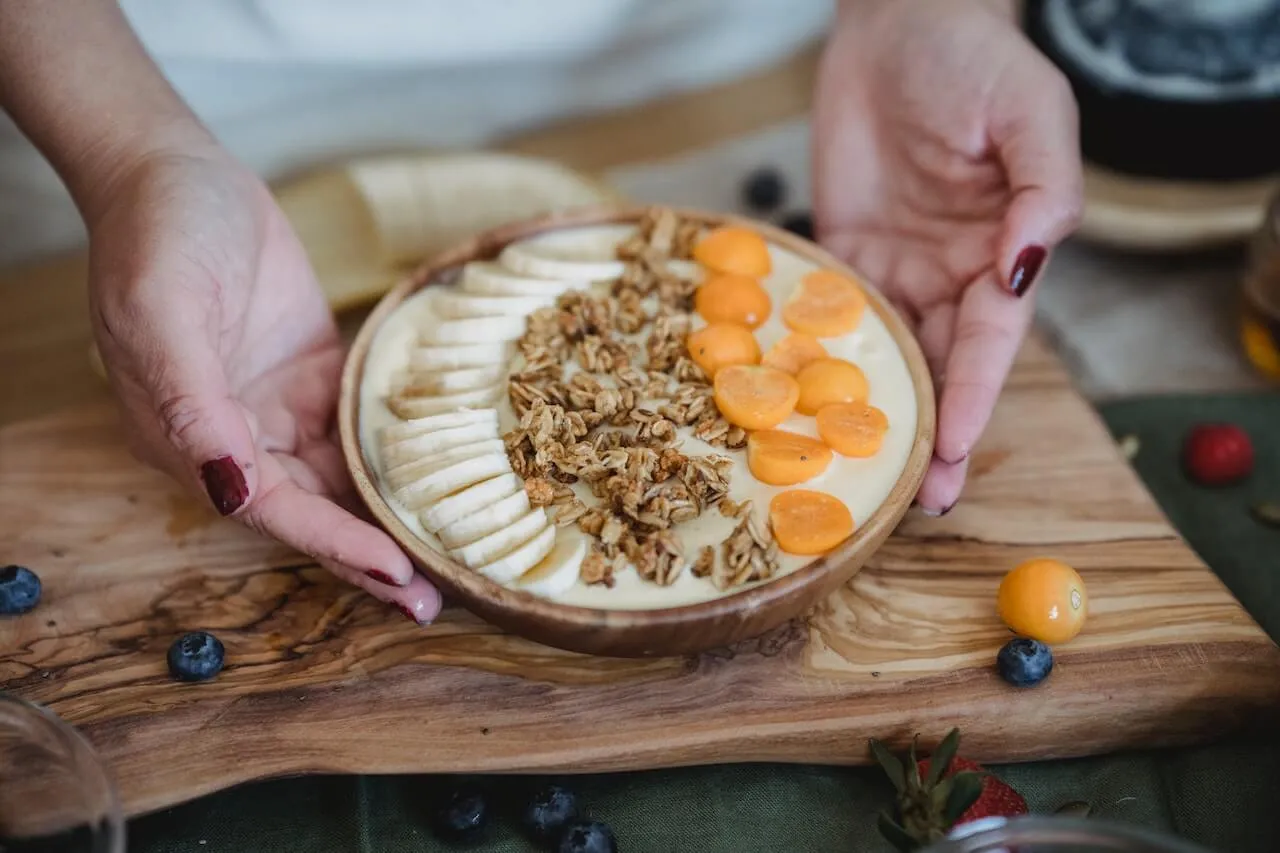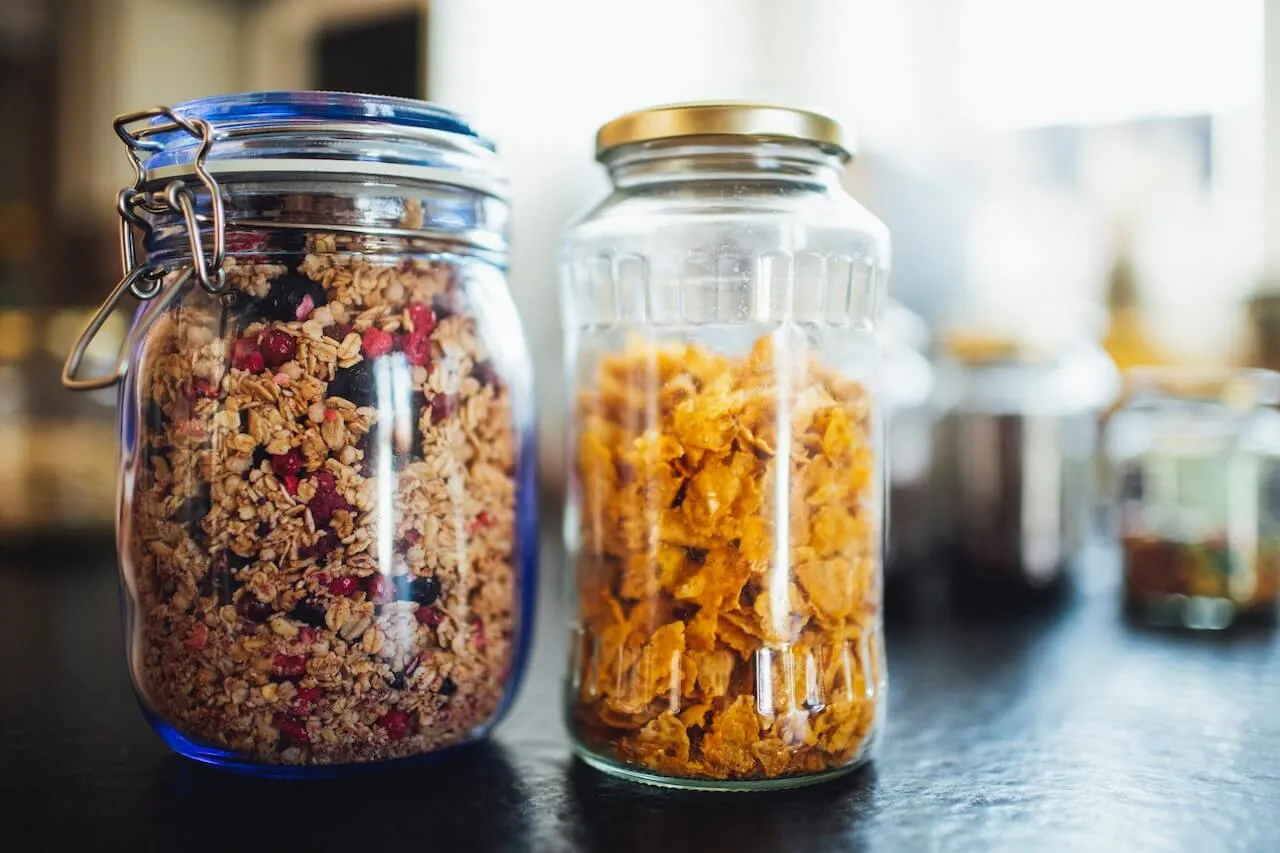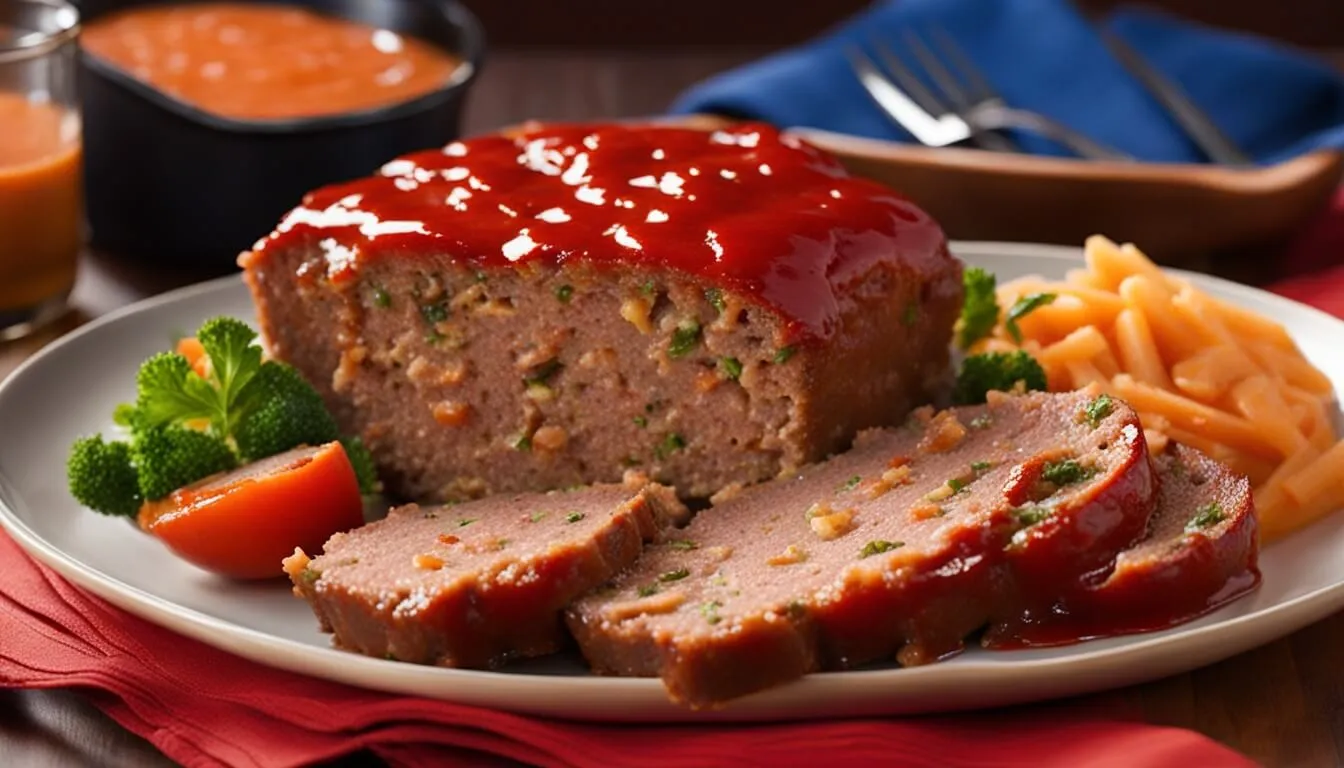Are you ready to start your day with whole grains, filling protein and fiber, and a nutritional kick? All it takes is a little prep work, 30 minutes in the oven, and time to cool, and you’ll be rewarded with the best granola that is low-glycemic and healthy.
{{mid-cta}}
Benefits of Healthy Granola
Granola has oodles of health benefits. It contains oats, which are gluten-free when uncontaminated by other grains and is rich in beta-glucan, which confers impressive health benefits. It can:
- Reduce blood glucose
- Lower blood cholesterol levels
- Improve insulin sensitivity
- Boost overall lipids
Adding granola to your regular diet could help you manage your health and weight more effectively. People who eat such foods for breakfast show reduced blood sugar levels. Combined with filling fiber, the overall effect keeps you sated, helping you avoid mindless snacking at your desk.
The oats in granola might even influence certain hormones, leading to weight loss. A recent 2023 meta-review found that oats have therapeutic potential in body weight management by altering leptin, ghrelin, cholecystokinin, oxyntomodulin, GLP-1, INSLP-5, and PYY levels.1
Granola Ingredients
Although granola varieties contain the same foundational ingredients, you can add nearly infinite variations. Learning how to make granola is a task even your middle school children can tackle once you trust them with the oven. Here are the four things necessary for homemade granola.
1. Oats
Oats are the main ingredient that granola is made of. Bake them to get a satisfying crunch. A bit of healthy oil, like coconut, is all you need for the right crispiness, and you already know oats are good for you.
2. Nuts
Some people debate whether nuts belong on the list of essential granola ingredients. It’s fine to omit them if you have an allergy.
However, those without issues should include nuts for the health benefits. They’re high in antioxidants and magnesium, selenium, and zinc. These three minerals work wonders for supporting positive mental health.2 Some of the most popular nuts in granola include pistachios, cashews, peanuts, almonds, and pecans.
For a creamier texture to your granola, you can also add peanut butter or almond butter to the recipe. Just be mindful of the added sugars that these ingredients may contain.
3. Low Glycemic Sweetener
Many people think “low-glycemic sweetener” means an artificial substance. However, you have natural choices. For example, maple syrup won’t spike blood glucose like white sugar or brown sugar. Honey is another alternative rich in antioxidants and has antimicrobial agents as a bonus. Using these substances results in a low-sugar granola recipe free of questionable ingredients.
4. Cinnamon
Ground cinnamon is a must as a classic granola ingredient. This spice can lower your blood sugar while providing other health benefits, such as protecting your heart and brain and helping you maintain your ideal weight.
How to Make Granola: 6 Steps

It’s a snap to make crunchy granola. This recipe is also naturally low in calories because of the all-natural ingredients. Here’s what you’ll need to gather before you begin making this homemade granola recipe:3
Serving size: 6 portions
- 2 cups old-fashioned rolled oats or rolled oats
- 1 cup pecans
- ½ cup sliced almonds
- ½ cup shredded coconut
- ¼ cup melted coconut oil
- ¼ cup maple syrup
- ½ cup raisins, pumpkin seeds (pepitas), or dried cranberries (optional)
- Sea salt to taste
1. Preheat the Oven
Preheat the oven to 300 degrees while you assemble your ingredients.
2. Mix the Dry Ingredients
Mix the oats, pecans, almonds, coconut shreds, and salt in a large bowl. Stir well.
3. Add the Wet Ingredients
Mix in the maple syrup and coconut oil into the mixing bowl and blend until you completely coat the dry ingredients.
4. Spread the Mixture
Line a sheet pan with parchment paper to prevent the granola from sticking to the pan. Press the mixture together into an even layer on the large baking sheet. The more tightly you pack it, the easier it will be to cut into squares. Loosely packed materials will result in a crumbly granola, which may be what you want.
5. Bake the Granola
Bake the mixture for 30 minutes or until it turns golden brown. Set a 15-minute timer and rotate the tray halfway through. Monitor the process, checking for edges that brown before the rest of the mix. Packing the granola evenly promotes better baking.
6. Let the Granola Cool
Here’s the tricky part: blend in the fruit immediately upon removing your granola from the oven while it remains piping hot. Immediately press any disturbed bits back into shape. However, waiting too long and letting it crumble makes a lovely granola cereal that tastes heavenly with milk.
Let your granola cool on the counter for approximately 30 minutes before popping it into the refrigerator. Once set, cut into the desired shapes. Slicing it into granola bars provides you with a low-glycemic breakfast recipe that you can grab and go, or use granola clusters as a topping for a bowl of Greek yogurt with fresh fruit.
Healthy Granola Alternatives
Although this healthy homemade granola is technically a high-carb food, it’s low on the glycemic index because complex carbs don’t spike your blood sugar like processed foods. It’s also not high in calories and minimizes your intake of unhealthy fats. You can add infinite twists to alter the taste slightly while keeping a low-calorie granola.
For example, many people substitute dark chocolate chips for maple syrup. Doing so results in a less sweet, more complex blend. It still treads lightly on your blood sugar, as dark chocolate may improve insulin sensitivity.
You can also experiment with different dried fruits. Banana chips and unsweetened coconut flakes subtly add sweetness to the granola. Dried mango, dried cherries, blueberries, apricots, and papaya can make your granola nearly as sweet as candy without adverse health effects.
Who says granola must be sweet? Experiment with savory blends, adding various herbs or even a touch of hot pepper. Capsaicin, which makes some peppers hot, also benefits blood sugar control.4
How to Store Homemade Granola

The best way to store your homemade granola is in a sealed, airtight container, such as a glass-lidded mason jar. A zipped plastic bag is also good for individual storage. Keep your bars in a cool, dry place. If they get too gooey, a few minutes in the oven refreshes their crunch.5
You can also freeze homemade granola for longer-lasting goodness. It will keep for three to six months in an airtight freezer bag.6 Use the oven trick if it thaws out too gooey.
Ways of Eating Healthy Granola
There are dozens of ways to eat healthy granola. It’s excellent any time of day, from breakfast to your post-workout snack and even the midnight munchies. Here are several fun ideas to whet your appetite:
- As a grab-and-go bar
- As a healthy breakfast with almond milk
- Sprinkled over yogurt as a quick parfait
- Added to a trail mix with other nuts and dried fruit
- Crumbled over ice cream or as an ice cream sandwich
- Baked into a healthy, hearty bread
- Added to Chex Mix for a gluten-free game-day snack
Healthy Granola FAQs
Here are answers to the most frequently asked questions about healthy granola.
1. How Long Should I Bake Granola?
The estimate for the total time to bake granola is 30 minutes, but baking times may vary depending on the thickness of your sheet. For best results, monitor your granola throughout baking, moving the tray if you notice certain areas browning more quickly than others.
2. How Can I Make Vegan Granola?
The recipe listed above is naturally vegan. It’s simple to convert nearly any recipe by substituting coconut oil for butter. You can also add flax seeds if you would like to include heart-healthy omega 3s in the granola. Adding in other vegan ingredients may alter the prep time.
3. Can I Use Sugar-Free Sweeteners in Healthy Granola?
You can use sugar-free sweeteners to make healthy granola. However, many artificial versions have raised questions about potential risks in recent years.7 Opting for monk fruit or stevia appeals to those who prefer to keep things natural.
4. How Can I Make Gluten-Free Granola?
Granola is also naturally gluten-free. Although oats contain no gluten, manufacturing can cross-contaminate them with other grains. Avoid trouble by ensuring the label on your chosen oats specifies a dedicated gluten-free production line.
5. Can I Eat Granola Every Day?
If you love granola, there’s no need to deprive yourself of this treat. Each 1-ounce bar of the above recipe has less than 150 calories, meaning it won’t pack on the pounds when eaten in moderation. Feel free to indulge in a daily bowl of granola cereal or take some each morning for breakfast on the go.
6. Is Homemade Granola GMO-Free?
Whether your homemade granola qualifies as GMO-free depends on the ingredients you choose. An easy hack to avoid such products is to buy organic foods. According to the U.S. Department of Agriculture, farmers who grow oats, pecans, and almonds for your favorite blend cannot use GMO seeds.
7. Does Granola Contain Peanuts?
Peanut allergies can be deadly. Although the recipe here uses no peanuts, some recipes include them. Check with the baker before consuming homemade granola that someone else made. There’s a high risk of cross-contamination between peanuts and various tree nuts, and some manufacturers may use peanut oil; read ingredient labels carefully.
Using a CGM with Signos: Real-Time Data, Backed by AI
Signos pairs a round-the-clock glucose biosensor with AI trained on tens of millions of data points to deliver personalized, science-backed guidance for weight management and health. See exactly how your body responds, and take action.
Please browse our blog for fabulous recipes that taste great while providing your body with the nutrition it needs. Are you ready to take your health to the next level?
Learn how it works. Ready to get started? Join now.
Topics discussed in this article:
References
1. Aadil, Rana Muhammad, et al. “Impact of Oats on Appetite Hormones and Body Weight Management: A Review.” NIH, 2023. Retrieved from: https://www.ncbi.nlm.nih.gov/pmc/articles/PMC9930024/
2. Li, Hui, et al. “Appropriate Macronutrients or Mineral Elements Are Beneficial to Improve Depression and Reduce the Risk of Depression.” International Journal of Molecular Sciences, 2023. Retrieved from: https://www.mdpi.com/1422-0067/24/8/7098
3. “Easy Homemade Pecan Granola Recipe.” Retrieved from: https://thepecannation.com/recipe/homemade-pecan-granola-recipe/
4. Uversky, Vladimir N. “Dietary Capsaicin: A Spicy Way to Improve Cardio-Metabolic Health?” PubMed Central, 2022. Retrieved from: https://www.ncbi.nlm.nih.gov/pmc/articles/PMC9775666/
5. Foster, Kelli. “This Is the Best Way to Revive Stale Granola.” Retrieved from: https://www.thekitchn.com/revive-stale-granola-22994429
6. “Granola Storage Tips: Plus, Can You Freeze Granola?” Retrieved from: https://thenessykitchen.com/granola-storage/#:~:text=In%20fact%2C%20freezing%20granola%2C%20when,6%20months%20in%20the%20freezer.
7. Alles, Benjamin, et al. “Artificial Sweeteners and Risk of Cardiovascular Diseases: Results From the Prospective NutriNet-Santi Cohort.” The BMJ, 2022. Retrieved from: https://www.bmj.com/content/378/bmj-2022-071204#:~:text=The%20WHO%202022%20report%20on,HDL%20cholesterol%20ratio%20




.svg)










.svg)
.svg)
.svg)
.svg)
.svg)
.svg)
.svg)
